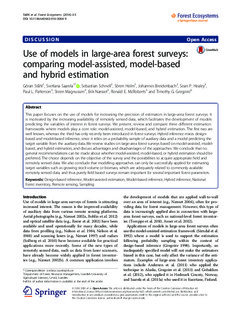Use of models in large-area forest surveys: comparing model-assisted, model-based and hybrid estimation
| dc.contributor.author | Ståhl, Göran | |
| dc.contributor.author | Saarela, Svetlana | |
| dc.contributor.author | Schnell, Sebastian | |
| dc.contributor.author | Holm, Sören | |
| dc.contributor.author | Breidenbach, Johannes | |
| dc.contributor.author | Healey, Sean P. | |
| dc.contributor.author | Patterson, Paul L. | |
| dc.contributor.author | Magnussen, Steen | |
| dc.contributor.author | Næsset, Erik | |
| dc.contributor.author | McRoberts, Ronald E. | |
| dc.contributor.author | Gregoire, Timothy G. | |
| dc.date.accessioned | 2018-05-29T12:02:18Z | |
| dc.date.available | 2018-05-29T12:02:18Z | |
| dc.date.created | 2017-01-13T13:52:10Z | |
| dc.date.issued | 2016 | |
| dc.identifier.citation | Ståhl, G., Saarela, S., Schnell, S., Holm, S., Breidenbach, J., Healey, S. P., ... & Gregoire, T. G. (2016). Use of models in large-area forest surveys: comparing model-assisted, model-based and hybrid estimation. Forest Ecosystems, 3(1), 5. | nb_NO |
| dc.identifier.issn | 2197-5620 | |
| dc.identifier.uri | http://hdl.handle.net/11250/2499602 | |
| dc.description.abstract | This paper focuses on the use of models for increasing the precision of estimators in large-area forest surveys. It is motivated by the increasing availability of remotely sensed data, which facilitates the development of models predicting the variables of interest in forest surveys. We present, review and compare three different estimation frameworks where models play a core role: model-assisted, model-based, and hybrid estimation. The first two are well known, whereas the third has only recently been introduced in forest surveys. Hybrid inference mixes design-based and model-based inference, since it relies on a probability sample of auxiliary data and a model predicting the target variable from the auxiliary data..We review studies on large-area forest surveys based on model-assisted, model-based, and hybrid estimation, and discuss advantages and disadvantages of the approaches. We conclude that no general recommendations can be made about whether model-assisted, model-based, or hybrid estimation should be preferred. The choice depends on the objective of the survey and the possibilities to acquire appropriate field and remotely sensed data. We also conclude that modelling approaches can only be successfully applied for estimating target variables such as growing stock volume or biomass, which are adequately related to commonly available remotely sensed data, and thus purely field based surveys remain important for several important forest parameters. | nb_NO |
| dc.language.iso | eng | nb_NO |
| dc.rights | Navngivelse 4.0 Internasjonal | * |
| dc.rights.uri | http://creativecommons.org/licenses/by/4.0/deed.no | * |
| dc.subject | Design-based inference | nb_NO |
| dc.subject | Model-assisted estimation | nb_NO |
| dc.subject | Model-based inference | nb_NO |
| dc.subject | Hybrid inference | nb_NO |
| dc.subject | National forest inventory | nb_NO |
| dc.subject | Remote sensing | nb_NO |
| dc.subject | Sampling | nb_NO |
| dc.title | Use of models in large-area forest surveys: comparing model-assisted, model-based and hybrid estimation | nb_NO |
| dc.type | Journal article | nb_NO |
| dc.type | Peer reviewed | nb_NO |
| dc.description.version | publishedVersion | nb_NO |
| dc.rights.holder | © Ståhl et al. 2016 | nb_NO |
| dc.source.pagenumber | 11 | nb_NO |
| dc.source.volume | 3 | nb_NO |
| dc.source.journal | Forest Ecosystems | nb_NO |
| dc.identifier.doi | 10.1186/s40663-016-0064-9 | |
| dc.identifier.cristin | 1426798 | |
| cristin.ispublished | true | |
| cristin.fulltext | original | |
| cristin.qualitycode | 1 |
Tilhørende fil(er)
Denne innførselen finnes i følgende samling(er)
-
Publikasjoner fra CRIStin - NIBIO [4500]
-
Vitenskapelige artikler [1416]

